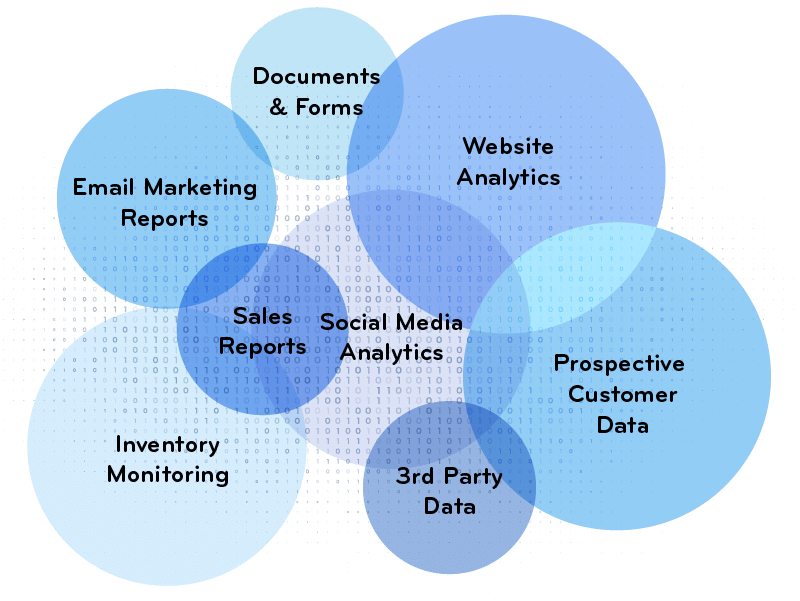Handle your Business Data with Purpose
July 27, 2021
Organizations are inundated with new data every day. Clickthrough rates, trending analytics, form submissions – this glut of data can be overwhelming. This data is a vital resource that can be used to guide decision-making and improve your business. However, with so much data to sort through, how do you even get started? In today’s interconnected environment, there is no stemming the flow of new information, so the challenge becomes better management.
Data flows in from a wide range of sources, and each type of data has unique applications. For example, social media analytics and industry trend data may help you determine future product offerings, while metadata can be used to track and organize content. Each type of data serves a specific business function, and each business may produce different types and quantities of data.

Some examples of data your organization might be gathering include:
- Social Media Analytics
- Employee Performance Data
- Personal Data for Customers or Employees
- Transactional Data
- Medical Data
- Communications – email, phone records, or meeting notes
- Inventory & Supply Chain Data
- Market or Industry Trends
- Financial Data
- Reference Data
- Metadata
- Form Submissions & Surveys
- 3rd Party Datasets
So how can your organization better manage this data? There isn’t a one size fits all answer. As with so many things, your data management strategy should be specific to your needs and challenges. However, some universal practices can help you better gather, track, and apply business data.
1. Define Your Goals First:
Having clear goals for what you want to gain from your data is the first step in any data management strategy. Are you trying to improve sales using customer buying analytics? Instead, maybe you’re interested in tracking health trends to determine the best time to schedule preventative screenings. Knowing what processes you want to improve or what you want to learn from the data (best time of day to send an email, which customers are most engaged etc.) will help you with step two – determining what data you need to collect.
2. Focus on Collecting the Data You Need & Not the Data You Don’t:
When gathering data, it’s essential that you set the right metrics. Gathering excessive data points (that you’ll likely never use) adds complexity without adding value. This is true whether you’re setting up something as simple as a contact form or developing a complex medical study. Stick to the goals you have defined for the data, and don’t waste energy on superfluous information. For example, if you are setting up a registration form for an upcoming webinar, you will likely include some contact fields such as email or phone number. You may be tempted to try and grab everything you can, including mailing address, contact hours, or in-depth demographic information. However, studies show that as forms increase in length the willingness of the participant to complete them drops. Unless you actually plan to run a direct mail campaign to this group of customers, adding an address field may be unnecessary, or worse appear invasive and thus stifle engagement.
3. Clearly Define Data Governance Policies:
This tip may seem obvious, but it’s one worth repeating. If you’re an organization that deals with sensitive information like financial, medical, or personal data, then you’ll already be familiar with the challenges of protecting private information. Each type of data has different handling concerns. If you want to be effective at processing this data, you will need to clearly define the handling procedures for sensitive content within the scope of current compliance regulations. Take the time to define your company’s policies for who should handle this data and how it should be used. Establishing a clear map for data ownership helps ensure that nothing gets missed. Also, it’s vital that these policies are accessible and that your employees are aware of them. If they aren’t read in, all the strategizing in the world won’t make a difference.
4. Strategically Apply Business Intelligence Tools:
What good is accessible digital data if you cannot understand it? Some data sets are simply too large or complex to analyze manually. This is where business intelligence (BI) tools can help. BI tools can be used to visualize data in convenient dashboards or automated reports. This helps you get better insight into your data and track the progress of a wide range of metrics.
5. Centralize and Secure Your Data:
Nothing is more frustrating than having valuable data trapped in an information silo. Data that is isolated from the rest of the company is difficult to integrate and is at risk of being lost. Effective electronic content management (ECM) will allow you to apply automation and even route your data to workflows.
Eliminating silos doesn’t mean compromising on security. Centralizing your content with a trusted ECM platform and implementing role-based access will ensure your data stays both secure and accessible. In addition to managed accessibility, an ECM can provide consistent updates and backups, ensuring everyone has the latest data and that you’re protected from the unexpected.
6. Automate, Automate, Automate:
Automation may be the missing piece in your data management strategy. Sorting, tagging, scrubbing, and interpreting data can translate to a lot of employee-hours. When possible, let automation take the reigns. Many cloud-based AI tools can simplify the organization and distribution of your data. This improves your bottom line and helps you ensure a positive ROI for your investment in data management.
Automation doesn’t eliminate the need for oversight, but it does improve accuracy and reduce repetitive work. Monitoring and alerts should be built into your strategy so that when necessary, a human can step in and ensure that things are running correctly.
7. Metadata Matters:
Metadata is essentially data that describes other data. That may seem redundant, but metadata is highly useful for search, indexing, and structuring data. Organizations should prioritize generating data that is clearly tagged with appropriate metadata. This sounds more complicated than it is, but it really just boils down to using sensible naming conventions and tagging important documents with the right sorts of information such as data type, client name, source, etc. When you’re working with large databases of files, it makes sense to ensure you can locate what you need quickly. The more consistent and robust your metadata, the easier this is. This is especially true if you’re using an ECM that has advanced search capabilities. Being able to find files based on the associated project or being able to track versioning can make other processes more consistent and efficient. Automation can help by allowing you to apply appropriate metadata in batches to massive collections of media.
8. Consult an Expert:
It’s easy to let good data management fall by the wayside, but it’s not something you should put off indefinitely. Data is becoming more and more critical to staying competitive. If you are struggling to get your data on track, don’t be afraid to seek out an expert.
How can DOMA help?
An effective data management strategy can help prevent data loss, reduce security risks, help you make better decisions, and improve your organization’s adaptability. DOMA can help you tackle challenges at any stage of the document and data management lifecycle. From backfile scanning to the latest in business intelligence, we are here to help you take the next step.
About DOMA- Powered by Tech, Driven by People
DOMA Technologies (DOMA) is a software development and digital transformation company whose mission is to change customer lives by lightening their workload through faster and more targeted access to their data. Since 2000, our team of 200+ experts has helped businesses navigate all aspects of the digital world. We are a dedicated strategic partner for the federal government and private sector clients at every stage of their unique digital transformation journey.

Author:
Danielle Wethington
Director of Communications
Sources:
Hyper Automation
What is hyper automation? Find out out about how AI tools can help you get more out of your data.
Recent News

Humanizing Healthcare

Reducing Improper Payments

Beyond the Merge: Alex Feliciano on Transforming Federal Healthcare

